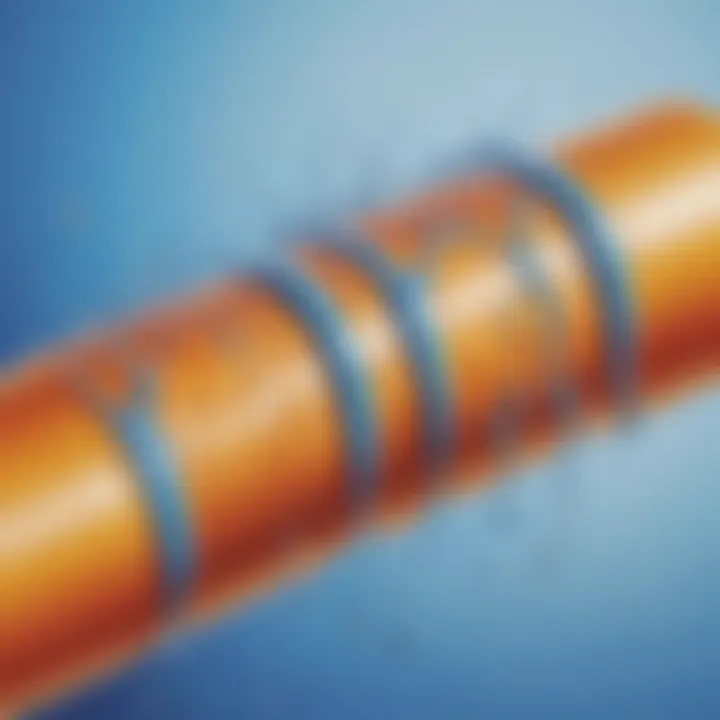Understanding Superabsorbent Polymers in Depth


Intro
In a world where water plays an essential role in the survival of plants, animals, and even humans, understanding how to retain this precious resource is crucial. Superabsorbent polymers (SAPs) are materials that can absorb and retain large amounts of water relative to their own mass. These polymers are designed to swell and form a gel-like substance when they come into contact with water. This property makes them invaluable in various fields, including agriculture, healthcare, and environmental management.
Superabsorbent polymers have revolutionized how we think about water retention. From helping farmers maintain soil moisture to aiding in wound care, their applications are vast. Let’s dive deeper into the fascinating world of SAPs and learn what makes them so special.
Science Fun Facts
Interesting Trivia and Facts
- Superabsorbent polymers can hold up to 300 times their weight in water, depending on their composition and structure.
- They are often made from acrylic acid or its sodium salt, which gives them their superabsorbent properties.
Quirky Science Stories
There’s a fascinating story behind how one popular superabsorbent polymer, polyacrylate, became a game-changer in the absorbent product industry. Initially developed for use in diapers, its incredible absorption capabilities soon caught the attention of not just manufacturers but also researchers looking to solve water retention issues in agriculture.
Amazing Science Records
Did you know that SAPs can be used to create artificial snow? Some companies produce a synthetic snow that retains water and can last for several days after it's applied! This is often used for festive decorations, giving a wintry feel without the chill.
Thought-Provoking Questions
- How do you think superabsorbent polymers could play a role in sustainable agricultural practices?
- What are some challenges you think we might face when using SAPs in everyday products?
Discover the Wonders of Science
Exploring Various Scientific Concepts
Superabsorbent polymers operate through a process called hydrophilicity, where the polymer chains attract water molecules. The intricate design of these materials allows them to expand and form a gel, locking in moisture efficiently.
Educational Videos and Animations
To appreciate SAPs even more, there are several educational videos available on platforms like YouTube that demonstrate how these amazing polymers work. Watching a video can help visualize their absorption process, making the science behind them more accessible.
Interactive Learning Tools
Websites like Khan Academy offer interactive tools for kids to learn more about polymers and their real-world applications. Learning about the hands-on applications can inspire creativity and curiosity.
Real-Life Applications of Science
In agriculture, farmers have begun utilizing SAPs to retain water in soil, reducing the need for frequent irrigation. In healthcare, these polymers are used in products such as wound dressings and adult diapers, ensuring minimal leakage and keeping the area dry. These applications show how far-reaching the impact of SAPs can be.
Science Quiz Time
Interactive Quizzes
To test your knowledge about superabsorbent polymers, several online quizzes can be found. Challenge yourself or your friends!
Multiple Choice Questions
- What is the primary component of many superabsorbent polymers?
- How many times can some SAPs absorb their weight in water?
- A) Polyester
- B) Polyacrylate
- C) Polyethylene
- A) Up to 50 times
- B) Up to 150 times
- C) Up to 300 times
Brain Teasers and Puzzles
If you enjoy puzzles, think about how you could design a product using superabsorbent polymers. What features would it have? How would it benefit the users?
Learning Through Gamification
Gamifying learning about SAPs not only makes it fun but also helps retain complex information. Through games, you can simulate the properties of these polymers and see just how much water they can hold.
Science Experiment Showcase
Fun and Engaging Experiments
One simple experiment involves comparing different types of materials for water retention. By using cotton, sand, and superabsorbent polymers, you can observe firsthand which absorbs the most water.
Step-by-Step Instructions
- Gather materials: cotton, sand, superabsorbent polymer, and water.
- Create small containers for each material.
- Pour the same amount of water into each container.
- After a given time (e.g., one hour), compare how much water each material has retained.
Materials List
- Cotton
- Sand
- Superabsorbent polymer (can be found in some gardening supplies)
- Water


Safety Tips and Precautions
Ensure to handle all materials safely, especially when dealing with chemicals. Always wash your hands after conducting the experiment and supervise young children.
Superabsorbent polymers present a world of possibilities that we are only beginning to explore. With ongoing research and innovation, future applications could make a significant difference in various sectors, helping us manage water more efficiently.
Intro to Superabsorbent Polymers
Superabsorbent polymers (SAPs) are fascinating materials that have found a home in various industries, touching lives in ways that many might not realize. Their ability to absorb and retain water is nothing short of remarkable, leading to significant breakthroughs in agriculture, medical fields, and other applications. As we journey further into the world of SAPs, it’s crucial to grasp not just what they are, but why they matter.
From the perspective of parents and caregivers, understanding superabsorbent polymers equips you to make informed decisions about products that could affect your family's health and the environment. With ever-growing concerns about water conservation and environmental sustainability, the role of SAPs is undeniably critical. These polymers are not just about water absorption; they integrate eco-friendly practices when properly applied, making them worthy of closer examination.
"Studying SAPs unveils pathways toward sustainable practices in water management, benefiting both fields and families alike."
With properties that allow them to absorb hundreds of times their weight in water, SAPs are essential in various consumer products, from diapers—helping keep babies dry—to soil management in gardens. The more we understand these polymers, the better we can appreciate their impact. Through this section, we'll take a closer look at what exactly superabsorbent polymers are, and explore the significance behind studying them.
Defining Superabsorbent Polymers
Superabsorbent polymers are a class of materials that can absorb and retain exceptionally large amounts of liquid relative to their own weight. The term “superabsorbent” is used because of their capability to soak up water in a way that ordinary materials, like towels or sponges, cannot. These polymers typically swell up when they come into contact with water, creating a gel-like substance.
Structurally, they are often made from synthetic materials that have been modified to enhance their absorption properties. Unlike traditional absorbents that merely hold onto liquid, SAPs can interact chemically with the liquid, which means they can keep moisture in place instead of just letting it evaporate away. This is especially vital in applications where moisture retention is crucial.
The Importance of Studying SAPs
The significance of studying superabsorbent polymers extends far beyond their water-holding capabilities.
- Water Conservation: With increasing concerns over water scarcity, understanding these materials can lead to innovative solutions for agriculture, landscaping, and industrial processes that aim to reduce water usage.
- Health Benefits: In the medical field, SAPs are used in products such as wound dressings, where moisture management can accelerate healing. By studying how these materials work, we can improve patient outcomes and product effectiveness.
- Environmental Impact: Many modern SAPs are being developed with a focus on biodegradability and sustainability. Researching their environmental footprint helps in creating products that are safer and more efficient, ultimately benefiting our planet.
In the grand scheme, grasping the nuances of superabsorbent polymers paves the way for fresh, impactful developments. As you read on, you will discover how these polymers are not just scientific curiosities, but fundamental components in the quest for sustainability and efficiency in various industries.
Chemical Composition of SAPs
The chemical composition of superabsorbent polymers (SAPs) plays a vital role in determining their function and effectiveness. Understanding this aspect reveals not only how these materials work but also how they can be tailored to meet various applications in different sectors. By delving into the polymer structure and the mechanisms of their formation, we gain insight into the benefits and considerations surrounding SAPs.
Polymer Structure and Types
At the heart of superabsorbent polymers is their unique structure, which is generally formed through a network of cross-linked polymer chains. This configuration is crucial for their ability to absorb and retain water. SAPs often contain hydrophilic groups, or water-attracting functionalities, which are the real heroes when it comes to their absorption capacity.
Typically, there are two main types of superabsorbent polymers:
- Natural SAPs: These are derived from naturally occurring substances. They include polysaccharides such as guar gum and cellulose. Because they come from nature, they are often more biodegradable and considered environmentally friendly.
- Synthetic SAPs: Made through chemical processes, these polymers often exhibit superior absorption properties. Polyacrylate types dominate this category, widely used in various products, from diapers to agricultural applications.
Different structures can improve their efficiency and response depending on the application. Some polymers are specifically designed for fast absorption, while others might emphasize retention capacity. It's this diversity in structure and composition that gives SAPs their wide-ranging utility in areas like healthcare, agriculture, and environmental management.
Crosslinking Mechanisms
The crosslinking process is essential in the production of superabsorbent polymers, as it forms the intricate network that enables their specific properties. Several methods can create these crosslinks:
- Chemical Crosslinking: This involves the use of chemical agents like N,N-methylene-bis-acrylamide. This chemical bonds polymer chains together, resulting in a stable structure capable of holding large amounts of liquid.
- Physical Crosslinking: This method utilizes physical forces instead of chemical reactions. Examples include moderate heating or freezing, which lock the polymers together without altering their chemical structure. This is more a gentle approach and may lead to less chemical waste.
The arrangement of these crosslinks not only influences the absorption capacity of SAPs but also impacts their mechanical properties, such as flexibility and strength. Consequently, scientists and manufacturers must carefully choose the method of crosslinking according to the desired application of the SAPs. Different crosslinking methods can lead to materials that are tailor-fitted to specific industrial needs or environmental concerns.
"The structure and crosslinking of superabsorbent polymers directly dictate their absorption properties and suitability for various applications."
A detailed understanding of the chemical composition of SAPs enhances our ability to innovate and adapt these materials to emerging challenges, whether they be in boosting agricultural productivity or creating more sustainable healthcare solutions.
Mechanisms of Water Absorption
In the realm of superabsorbent polymers (SAPs), understanding the mechanisms of water absorption is paramount. This knowledge not only sheds light on how these materials function but also elucidates their vast potential in various applications. The unique ability of SAPs to retain water significantly hinges on two critical concepts: hydrophilicity and capillary action. Delving deep into these mechanisms helps us appreciate their relevance in agriculture, healthcare, and environmental solutions.
Hydrophilicity and Ion Exchange
Hydrophilicity refers to the tendency of a substance to attract and retain water. Superabsorbent polymers are designed with chemical structures that promote hydrophilicity, allowing them to absorb vast amounts of moisture. This quality arises from the presence of polar functional groups within the polymer chain, such as carboxyl or hydroxyl groups, which can interact favorably with water molecules.
Ion exchange plays a significant role in this absorptive action. Here, the polymer exchanges certain ions with water or other solutions. For instance, when a superabsorbent polymer comes into contact with a liquid that has ions in it, the SAP can swap out some of its ions for others present in the liquid. This exchange not only facilitates water absorption but can also alter the water retention properties and responsiveness to the surrounding environment.
Benefits of understanding hydrophilicity and ion exchange include:
- Enhanced efficiency in water-retaining applications
- Improved performance in agriculture by providing consistent moisture to plants
- Customizable characteristics for specific uses in healthcare, such as wound dressings
Capillary Action in SAPs
Capillary action is the process that allows liquids to flow in narrow spaces without the assistance of external forces. This principle is particularly relevant to superabsorbent polymers, where the internal structure of the material creates tiny pathways that facilitate water movement. When a SAP comes into contact with water, the strong adhesive forces between the water molecules and the polymer pull more water into the SAP.
The tiny pores and channels created through the polymer’s network structure significantly amplify this ability. As the water enters these channels, it spreads out evenly throughout the polymer's matrix, leading to rapid and effective absorption.
The importance of capillary action can be summarized with these points:


- Sap flexibility to control water release rates
- Broadening the potential for applications in various environmental conditions
- Creating materials that can respond dynamically to moisture changes
Understanding these mechanisms is vital for developing effective SAPs tailored to specific needs, from enhancing agricultural practices to improving medical treatments.
Applications of Superabsorbent Polymers
Superabsorbent polymers (SAPs) serve a plethora of purposes across various industries, playing an essential role that often goes unnoticed. Their ability to absorb and retain large quantities of water makes them invaluable in practices ranging from agriculture to healthcare. Understanding these applications is not just about knowing how SAPs function; it's about appreciating their significant contributions to enhancing efficiencies in multiple domains.
Agriculture and Horticulture
In the world of agriculture, the application of superabsorbent polymers has been a game changer. Farmers today face increasingly erratic weather patterns—droughts, floods, and everything in between. SAPs help in combatting these issues by improving soil moisture retention.
- How it Works: When mixed into soil, SAPs swell and retain water like a sponge, releasing it gradually as the plants need it. This process not only reduces the frequency of irrigation but also conserves water resources, which is a pressing concern in regions where water scarcity is rampant.
- Benefits: The incorporation of SAPs can enhance crop yields significantly. Studies have shown that crops such as corn and tomato thrive better in soil enriched with superabsorbent polymers. In fact, farmers can achieve better productivity with less water compared to traditional methods. Furthermore, they help maintain ground moisture which is particularly beneficial for seedlings in early growth stages.
The adoption of SAPs in horticulture is equally promising. Nurseries utilize these polymers to ensure that young plants receive adequate moisture, especially during the critical establishment phase. With increasing urbanization, these methods could mean lush gardens without the waste of precious resources.
Medical and Healthcare Uses
Moving beyond agriculture, SAPs have found a place in healthcare—quite literally in products intended for patient care. Superabsorbent polymers are integral to the manufacturing of absorbent medical dressings and hygiene products like diapers.
- Wound Care: In the medical field, SAPs are employed in wound dressings to absorb exudate, therefore maintaining a moist environment conducive for healing. This can help prevent infections and speed up recovery times.
- Diapers and Incontinence Products: Furthermore, incontinence pads and baby diapers leverage the unique properties of SAPs to control odors and keep skin dry. This function not only provides comfort but also ensures hygiene—an essential aspect for hospitals and care homes.
Importantly, these polymers can reduce the frequency of product changes, thus lowering costs for healthcare providers. A marrying of innovation and practicality, the use of SAPs in this sector highlights their versatility across various applications.
Environmental Applications
Superabsorbent polymers do not stop at agriculture and medicine; they also offer solutions for environmental challenges. Water management is a key area where these polymers excel.
- Water Conservation: By incorporating SAPs in land reclamation and erosion control, water retention in degraded land can be improved significantly. This is critical in areas facing desertification.
- Wastewater Management: Furthermore, SAPs are actively being researched for their potential use in wastewater treatment processes. Their absorbent qualities can aid in filtering out contaminants, ultimately leading to cleaner water systems.
"By leveraging the qualities of superabsorbent polymers, we can create sustainable solutions that address some of today's most critical environmental issues."
Additionally, SAPs can be used in manufacturing eco-friendly products, promoting sustainability by reducing the need for chemical additives in soil management. As awareness of environmental issues continues to grow, the relevance and need for materials like superabsorbent polymers are only bound to rise.
In summary, the applications of superabsorbent polymers are extensive and impactful, ranging from agriculture to healthcare to environmental conservation. Understanding their benefits helps to grasp their significance within modern practices across multiple fields.
Superabsorbent Polymers in Context
Understanding superabsorbent polymers (SAPs) requires looking at them through a historical lens and recognizing how they stack up against traditional absorbents. These aspects put SAPs into sharper focus, showcasing their evolution, current impact, and future potential in various fields.
Historical Background of SAPs
The journey of superabsorbent polymers began in the late 1960s. Researchers were on the lookout for materials that could hold vast amounts of liquid in their structure. The first significant advancements came when scientists started developing modified starches and more complex polymer networks. These scientists didn't just stumble upon a new chemical; they paved the way for innovations that would soon affect agriculture and healthcare significantly.
As technology marched on through the decades, advancements in synthetic methods further improved the capacity of these polymers to absorb water. By the 1980s, SAPs were finding a spot in baby diapers, transforming the industry with their ability to keep moisture away from a baby's skin. This was the defining moment when the potential of SAPs became widely recognized, marking their transition from laboratory research to everyday uses.
Moreover, even as we step into the 21st century, more breakthroughs continue to emerge, showcasing greener alternatives and smart applications. Today’s research is not just about absorbing water; it’s about finding eco-friendly solutions that can serve future generations. The knowledge gathered over several decades of study illustrates the versatility and adaptability of these polymers, making the historical context crucial to grasping their ongoing relevance.
Comparison With Traditional Absorbents
When comparing superabsorbent polymers to traditional absorbents like cotton, sponges, or even natural fibers, the differences become clear as day. While conventional materials absorb moisture to an extent, they often fall short when it comes to retention and release capabilities. For example:
- Water Retention: Traditional absorbents can only maintain a limited amount of liquid before saturation, whereas SAPs can hold hundreds of times their weight in water.
- Reusability: Traditional materials may require frequent replacement, while SAPs maintain functionality over extended periods under the right conditions.
- Size and Weight: SAPs can absorb much larger quantities of water without bulk, making them lightweight and efficient for use in various applications.
"SAPs revolutionize industries by minimizing waste and maximizing efficiency, turning the game on conventional absorbents."
Moreover, SAPs don’t just absorb water; they do so selectively through ion exchange, making them suitable for specialized environments like agri-tech or healthcare. For instance, in a hospital environment, using SAPs means a dry surface for cleanliness, reducing the risk of infection, unlike using traditional materials that may not have such capabilities. Their adaptability and superior performance certainly suggest that superabsorbent polymers are not merely alternatives but vital components in modern industrial practices.
In summary, understanding the context around superabsorbent polymers enriches our insight into their extensive role across multiple sectors. Their historical backdrop sheds light on how far we’ve come and highlights the technological advancements ahead in this fascinating field.
Challenges and Limitations of SAPs
Superabsorbent polymers (SAPs) are impressive materials that hold significant potential across various fields. However, their use comes with a set of challenges that also require careful consideration. Understanding these obstacles is crucial for researchers, manufacturers, and consumers alike, as it elucidates both the benefits and the pitfalls associated with these materials. Hence, delving into the challenges and limitations of SAPs not only grounds our appreciation but also informs future innovations and applications.
Degradation and Environmental Impact
One major concern surrounding superabsorbent polymers is their degradation process. Many traditional SAPs are made from synthetic materials, which can take a considerable amount of time to break down when disposed of. This leads to environmental issues, as these polymers can contribute to pollution if not properly managed. Unlike natural substances that readily decompose, synthetic SAPs can linger in landfills or ecosystems for many years, affecting soil and water quality.
- Non-biodegradable options: Commonly used SAPs are based on acrylic polymers which, despite their useful properties, don't naturally decompose. This fact raises crucial questions about their longevity in the environment.
- Microplastic formation: As these materials degrade, they can fragment into microplastics. These tiny particles pose a risk to marine life and ultimately can end up in our food chain.
- Research into alternatives: Luckily, strides are being made toward the development of biodegradable SAPs. These alternatives are designed to break down more efficiently in natural environments, lessening the long-term repercussions.
The understanding and further development of more sustainable SAPs is critical. Society is becoming increasingly aware of environmental stewardship. Addressing the degradation issue could help companies create more viable solutions that not only perform well but also align with global ecological principles.
Cost and Production Challenges
Another facet of the challenges presented by SAPs lies within their production. While they offer impressive water retention capabilities, the costs associated with manufacturing and processing them can become barriers for widespread adoption.
- Raw materials: The primary ingredients used in SAP manufacturing can be expensive and subject to fluctuating market prices. This can hinder manufacturers from keeping costs low.
- Processing techniques: The production process often requires specialized equipment and technology, leading to increased overhead costs. Small-scale producers might struggle to compete with larger companies that can leverage economies of scale.
- Testing and certification: Furthermore, before SAPs can be utilized in various industries, they often undergo rigorous testing to ensure safety and efficiency. This regulatory hurdle can also add to the expenses involved in bringing these products to market.


- Market demand: Even if a manufacturer can navigate the production costs, there's still the question of market demand for SAPs. If the end-user isn't willing to pay a premium for enhanced performance, the entire effort may fall flat, creating a cycle of wasteful spending.
- Innovation needs support: For the situation to improve, there's a need for stakeholders to invest in research and innovation. By exploring new manufacturing methods that could cut costs or finding ways to source raw materials more sustainably, the SAP industry could see significant advancements.
In summary, while superabsorbent polymers hold remarkable promise, the challenges related to their environmental impact and production costs cannot be ignored. Addressing these factors will not only enhance the viability of SAP applications but can help foster a deeper integration of sustainability within this material science field.
"Navigating the hurdles of SAP technology requires inventive thinking and a commitment to sustainability for future generations."
To learn more about superabsorbent polymers and their impact, consider checking out additional resources on platforms such as Wikipedia or Britannica.
Understanding these challenges paves the way for informed discussions about how this fascinating material can evolve and meet the needs of tomorrow.
Innovations in Superabsorbent Polymers
The realm of superabsorbent polymers is burgeoning with innovations that not only enhance their performance but also adapt to the pressing demands of modern society. As we tread further into an era characterized by sustainability and technology integration, the importance of new advancements in SAPs cannot be overstated. These innovations hold promise not just for improving existing products but also for navigating the challenges posed by environmental concerns and the quest for efficiency.
Here, we will delve into two exciting trends shaping this field: the development of biodegradable alternatives and the emergence of smart, responsive materials. Each of these strides promises to redefine how we perceive and utilize superabsorbent polymers.
Biodegradable SAP Alternatives
The appetite for sustainability is growing, prompting a robust interest in biodegradable superabsorbent polymers. Traditional SAPs, while effective, often face criticism for their environmental footprint. This has led researchers to design alternatives that can break down naturally over time, reducing long-term waste.
Benefits of Biodegradable SAPs
- Environmental Responsibility: These materials minimize pollution as they decompose, which is crucial in industries such as agriculture where large quantities are used.
- Soil Health: Once degraded, they can enhance soil quality by releasing nutrients back into the earth.
- Eco-friendly Disposal: Users can eliminate disposal concerns since these polymers do not linger in landfills or ecosystems.
Yet, developing biodegradable SAPs comes with considerations. It’s not just about making something that disappears; it also needs to perform. This means achieving the same or better water retention and absorption rates as conventional polymers while ensuring they fulfill their purpose in challenging conditions.
Smart SAPs and Responsive Materials
Smart superabsorbent polymers are akin to a Swiss army knife in the material world. They don’t just absorb water; they can adjust their performance based on environmental stimuli, like changes in humidity or temperature. This adaptability opens up a plethora of applications.
For example, imagine a soil additive that releases moisture only when plants need it, conserving water and ensuring plants stay healthy without over-saturation. An additional benefit includes the controlled release of nutrients, which can enhance agricultural efficiency.
Key Features of Smart SAPs
- Sensor Integration: Some can detect moisture levels and release water accordingly, optimizing resource use.
- Temperature Sensitivity: A shift in temperature can trigger a response, allowing these materials to expand or contract, adapting to their surroundings.
- Wider Applications: Beyond agriculture, they hold potential in personal care products, such as diapers that can adjust their absorption based on the amount of liquid they encounter.
The future of superabsorbent polymers is not just about improving absorption; it’s about being smarter, more responsive, and ultimately contributing to a more sustainable and efficient world.
As both biodegradable alternatives and smart functionalities evolve, they promise to broaden the applications of SAPs. The potential for these innovations to transform industries and practices is immense, making them an exciting focal point in ongoing research and development.
Future Trends and Research Directions
The world of superabsorbent polymers (SAPs) is always evolving. As we move further into the 21st century, it becomes increasingly critical to understand where this technology is headed. The importance of recognizing future trends and research directions cannot be overstated—knowing what’s coming can help us leverage these materials to address pressing issues across various sectors.
Emerging Applications of SAPs
SAPs have traditionally been associated with products like diapers and agricultural treatments. However, there's a tidal wave of new applications surfacing. Here are some significant areas where they’re beginning to shine:
- Wound Care: SAPs are playing a pivotal role in medical dressings. Their ability to manage fluid secretion helps create the ideal environment for wound healing, reducing recovery time.
- Water-Saving Solutions in Landscaping: With climate change creating increasing pressure on water resources, SAPs can help conserve moisture in soil, allowing plants to stay healthy with less watering.
- Food Packaging: The food industry can really benefit from SAPs in keeping produce fresher for longer. They can absorb excess moisture, which is a game changer for reducing food spoilage in transport.
Such diverse applications highlight the potential for SAP innovation in everyday life. As researchers dig deeper, we may find even more creative uses for these adaptable materials.
The Role of Nanotechnology in SAPs
Nanotechnology is like the cherry on top of the already potent capabilities of superabsorbent polymers. By manipulating materials at the nanoscale, scientists are opening doors to new functionalities that could make SAPs more effective than ever:
- Improved Absorption Rates: Nanoparticles can increase the surface area of SAPs, allowing them to absorb water faster and in greater quantities.
- Targeted Drug Delivery: In healthcare, integrating nanotechnology can lead to SAPs that release drugs at controlled rates, significantly improving patient outcomes.
- Environmental Monitoring: SAPs engineered with nanosensors could help track soil moisture levels in real-time, providing farmers with crucial data to optimize irrigation practices.
As we move ahead, pairing SAPs with nanotechnology seems to pave the way for advances that may once have seemed like science fiction. Drawing connections between these innovative realms could lead us to solutions previously thought unattainable. This intersection not only adds value to SAPs but can also help in addressing global challenges such as food security and health crises, making it an area worth watching.
"The future of superabsorbent polymers is bright, with endless possibilities on the horizon. As researchers and industries collaborate, the impact of these materials could be profound."
In sum, the continued exploration of superabsorbent polymers, particularly on emerging applications and the incorporation of nanotechnology, offers a glimpse into an exciting future. Such innovations will empower various sectors to address their unique challenges while promoting sustainability and efficiency.
Finale: The Significance of Superabsorbent Polymers
Superabsorbent polymers possess a unique set of properties that make them important across various applications, from agriculture to healthcare and even environmental management. Understanding their significance is crucial, as these materials play a vital role in managing water resources efficiently. As the world faces pressing challenges like water scarcity and environmental degradation, the need for effective solutions becomes even more pertinent. Superabsorbent polymers stand out in this regard because they can absorb large quantities of liquid relative to their own mass, which is particularly beneficial in regions that grapple with drought conditions.
In agriculture, for instance, the use of SAPs can lead to better soil moisture retention. This not only supports crop growth but also reduces the frequency of irrigation, conserving valuable water resources. Similarly, in the healthcare sector, superabsorbent materials are essential in the production of modern wound dressings and incontinence products, maximizing comfort and hygiene for patients.
Moreover, from an environmental perspective, these polymers can be instrumental in managing spills or excess moisture in various settings. By using superabsorbent materials, we can mitigate the effects of excessive rainwater or industrial spills, reducing the potential for damage and pollution.
Recap of Key Insights
To sum it all up, the key insights we've discussed throughout this article include:
- Diverse Applications: Superabsorbent polymers find applications in agriculture, healthcare, and environmental management.
- Water Retention: Their remarkable ability to retain water can help address issues related to droughts and water shortages.
- Innovative Materials: Ongoing research is focused on developing biodegradable and smart SAPs to enhance their functionality and reduce environmental impact.
It’s essential to appreciate these materials not just for their immediate benefits but also for how they can contribute to sustainable practices in various sectors.
Final Thoughts on Future Developments
Looking ahead, the future of superabsorbent polymers seems promising. Researchers are actively exploring new formulations that enhance their efficiency while minimizing environmental impact. Innovations like biodegradable superabsorbents and tailored solutions for specific applications are on the rise. The integration of nanotechnology into SAP development could pave the way for smarter materials that respond to environmental changes, providing solutions that are both proactive and reactive.
As awareness of sustainability grows globally, the demand for effective, eco-friendly superabsorbent polymers is likely to increase. Keeping an eye on emerging research will be vital for anyone interested in the role of these materials in addressing contemporary challenges. Engaging with communities and organizations dedicated to advancing these innovations can open doors to new applications, ultimately maximizing the benefits that superabsorbent polymers can offer.







